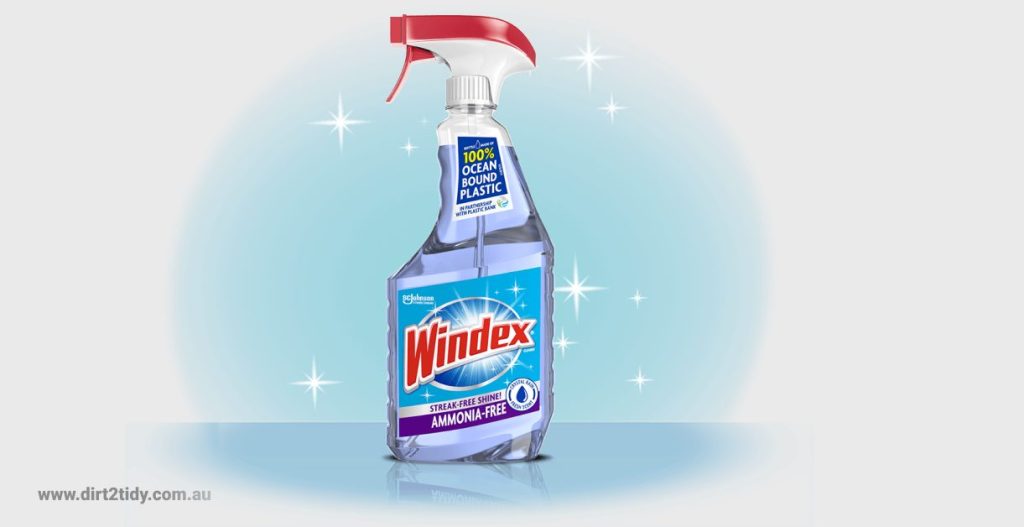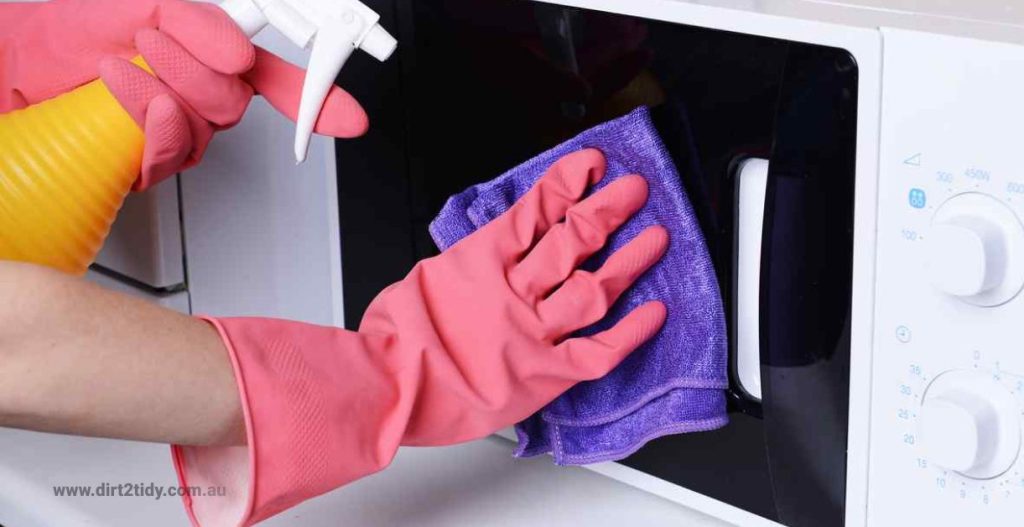Table of Contents
While a microwave is a convenient kitchen appliance, using the wrong cleaning products can pose serious health risks. Let’s explore whether cleaning sprays are safe for your microwave, what risks they carry, and the best cleaning methods for a safe and hygienic kitchen.
No, it is not hazardous to the clean a microwave, however it may be if the residue of cleaning products on the interior is not completely removed before using the oven again.
Use a natural and safe interior cleanser that works efficiently, and the only real problem is when you open the door after heating this combination in high power.
How Often Should You Clean Your Microwave?
Wipe the interior weekly for regular use, and do a deeper clean every couple of weeks for heavy use. Clean immediately if you notice odors or food debris to keep it hygienic and efficient.
Challenges of Using Cleaning Sprays in a Microwave
1. Chemical Residue & Food Contamination
Many commercial cleaning sprays contain harsh chemicals that can leave a toxic residue inside your microwave. When heated, these chemicals can release harmful fumes or even seep into food, posing serious health risks.
2. Risk of Fire & Toxic Fumes
Certain cleaning sprays contain flammable ingredients, which, when exposed to high microwave temperatures, could create toxic fumes or even cause small fires. Using the wrong cleaner can turn a simple cleaning job into a dangerous situation.
3. Corrosion & Damage to Microwave Interior
Some strong chemical sprays can damage the microwave’s protective coating, leading to rust, electrical issues, or reduced efficiency over time. Microwaves are designed with specific materials that can react poorly to certain cleaning agents.
4. Strong Odors & Lingering Smell
Harsh cleaning sprays often leave behind strong chemical odors that can absorb into food when reheated. This can alter the taste and safety of your meals, making natural cleaning alternatives a safer option.
How to Tell if Brown Stains Are Food or Rust
Food stains are usually sticky or greasy and wipe away with a damp cloth, while rust feels rough, may flake, and often appears where coating is chipped. Use natural cleaners for food residue, but replace the microwave if rust is present to stay safe.
Difficulties in Cleaning a Microwave Safely
✔ Finding a Safe Cleaning Method – Many sprays are not labeled microwave-safe, making it hard to choose the right one.
✔ Removing Grease & Stubborn Stains – Food splatters and oil residue can become hardened, making it difficult to clean without scrubbing.
✔ Avoiding Excess Moisture – Too much liquid inside the microwave can damage electrical components, leading to short circuits or malfunctions.
✔ Proper Ventilation – Cleaning without ventilation can trap chemical fumes, affecting indoor air quality and leaving an unpleasant smell.
Tackling Grease Build-Up Safely
Loosen microwave grease by steaming lemon slices or a vinegar-water mix, or use a baking soda paste. Mild dish soap with a soft cloth also works—avoid abrasive pads and harsh chemicals to protect the interior.
The following should NOT be used to clean your oven
Harsher chemicals may be used to clean a microwave’s outside when door closed. However, it is not advised to leave the door open. However, never use strong chemicals inside your equipment or leave a damp cloth inside.
Harsh chemicals may leave residues, and the aroma will remain for a long time after usage. This may ruin the flavour of your meal and even infect it even the food is in a microwave safe bowl.
Bleach
Bleach or baking soda is a caustic and very effective cleaning chemical. This material, which is made up of multiple harsh chemicals, cuts through and destroys practically anything it comes into touch with
Bleach is a chemical compound that contains sodium hydroxide, calcium hypochlorite, hydrogen peroxide, and sodium hypochlorite.Because some bleach contains chlorine, it reacts with other home all purpose cleaners.
You may also like to read about – “What does the vent fan on a microwave do?“
Although it is ideal for use in restrooms, hospitals, and other extremely polluted areas, it should be used with caution in the kitchen. Bleach produces a residue that may contaminate food and has a strong, unpleasant odour. To avoid contamination and unpleasant odours, do not use this in your microwave.

Cleaners such as Clorox and powdered bleach
Microwaves should not be cleaned with Clorox, Commit, or other powdered bleaches. They not only include the harsh components present in bleach, but they also contain them in greater concentrations and can be used for outside the microwave door.
Using Clorox, Commit, or other powdered bleach might corrode and harm your microwave.
You may use it on the exterior of your computer if you are cautious, but we do not encourage it. It is corrosive and may damage and corrode the machine’s metal components.
You may also like to read about – “What appliances have to be included in a kitchen?“
Cleaners of Clothes – Clean a Microwave
Dish soaps have a lower concentration than borax, powdered fabric cleaners, and liquid cleansers. These cleansers, although not as caustic as bleach, might leave dangerous residue in your machine.
After cleaning your machine with these soaps, you may discover that your food tastes soapy and unpleasant. We do not suggest putting them in your microwave since they might cause diarrhoea and other stomach disorders.
Ammonia such as Windex and other
Ammonia-Based Cleaners
Ammonia is an extremely toxic cleanser that may be used to destroy microorganisms. It is, however, hazardous when used in confined, unventilated locations or when combined with chlorine bleach. Ammonia has a strong odour that might harm the respiratory system and irritate the nose.
Much like bleach, ammonia-based cleaners leave behind a residue that is very difficult to remove from your microwave. This might result in cross-contamination and the discharge of hazardous gases into the air. Even if you think you’ve thoroughly wiped down every surface, microscopic traces can remain, contaminating your food and imparting an unpleasant, chemical-like taste.
Additionally, the potent fumes released by ammonia can linger inside your microwave, especially in the tight, enclosed space, making every subsequent use a potentially noxious experience. For your health and safety, it’s best to avoid products like Windex, glass cleaners, or any cleaning solution where ammonia is a key ingredient. Always choose gentler, food-safe options for your microwave to prevent accidental inhalation or ingestion of harmful substances.

Harsh Grease Cutters and Oven Cleaner
Oven cleansers are intended for use in industrial-style ovens. They contain strong and possibly hazardous compounds that should not be microwaved.
Oven cleansers and degreasers may be dangerous if ingested and create a strong odour. Avoid contaminating your microwave oven by only using these cleansers on their approved surfaces.
You may also like to read about – “Kitchen Cleaning Hacks for Easy Cleaning That Save Time“
Worst Microwave Sponges dampened and Cleaning Devices
In your microwave, never use abrasive sponges or cleaning utensils. Brillo pads, metal scrunchies scrubbers, and other abrasive cleaning sponges might destroy the protective coating of your microwave.
Use only semi-abrasive cleaning equipment to clean a microwave interior and exterior of your machine like a paper towel. Rust may cause your microwave’s interior mechanical workings to get moist or polluted with food, causing it to break down.
How to Clean Your Microwave with White Vinegar
Fill a microwave-safe bowl with 500 ml water and 2 tbsp vinegar. Microwave on high for 5 minutes, then let steam sit for 3 minutes. Carefully remove the bowl, take out the turntable, and wipe the interior with a damp cloth. Clean the turntable, dry all surfaces, and reassemble. This natural method removes grime without harsh chemicals.
Cleaning Tips for Microwaves
If you don’t have dish soap or vinegar, simmer half a lemon in a cup of water for five minutes. This all-natural cleaning solution has a pleasant citrous fragrance.
Microwave Cleaning with Lemon
Squeeze a lemon into a microwave-safe bowl, add the halves and 1 cup (230 ml) water. Microwave 3–5 minutes, then let steam sit 2–3 minutes. Carefully remove, wipe the interior, and wash the turntable separately.
A sponge heated in the microwave will clean it.
This simple lemon-steam trick not only leaves your microwave sparkling but also infuses it with a fresh, natural scent—no harsh chemicals required.
When cleaning your microwave, never use harsh or abrasive chemicals.
Covering food while it’s cooking inside the microwave keeps it clean and prevents spillage.
When heating splatter-prone meals, use a low power level and immediately remove the bowl, wipe up any spills.
Conclusion
Using cleaning sprays in your microwave may seem like a quick fix, but it can lead to chemical residues, toxic fumes, and potential appliance damage. Many conventional sprays contain harsh chemicals that, when exposed to high heat, can contaminate food and create health risks.
Built-up food in your microwave can reduce efficiency, pose fire risks, and void warranties. Regular cleaning ensures safety and extends the appliance’s lifespan.
For a safe and effective microwave cleaning, opt for natural solutions like vinegar, baking soda, or steam cleaning. These methods ensure your microwave remains odor-free, bacteria-free, and safe for cooking.
How Often Should You Clean Your Microwave?
Wipe daily-use microwaves weekly and deep clean every few weeks. Regular maintenance prevents stubborn stains and makes cleaning easier.
If you’re unsure how to deep clean your microwave and kitchen appliances without risks, let Dirt2Tidy’s professional cleaning services handle it for you! Our food-safe, eco-friendly cleaning techniques ensure your kitchen remains hygienic, grease-free, and free from harmful chemicals.





